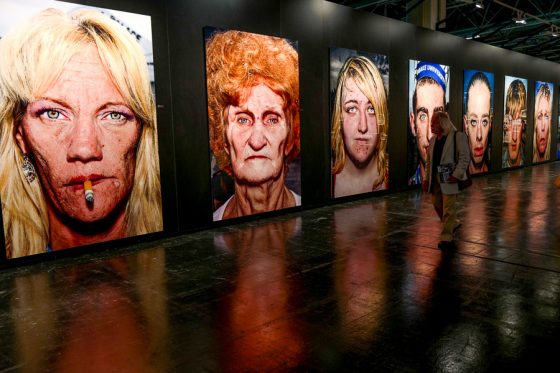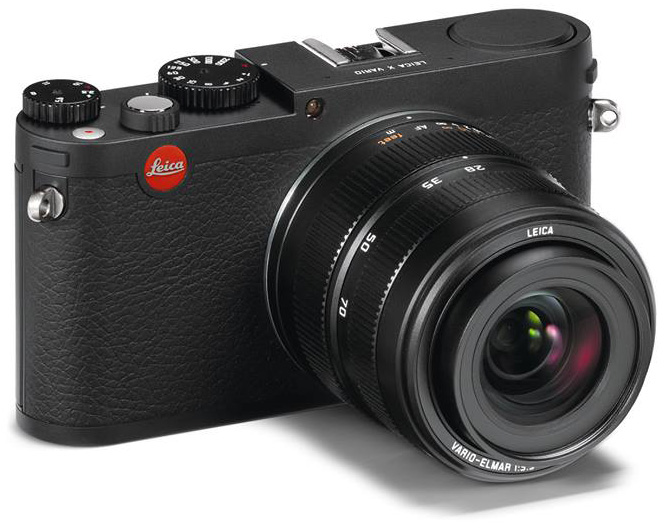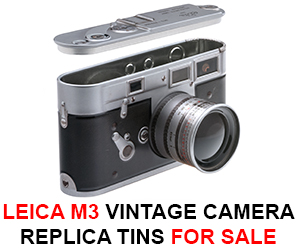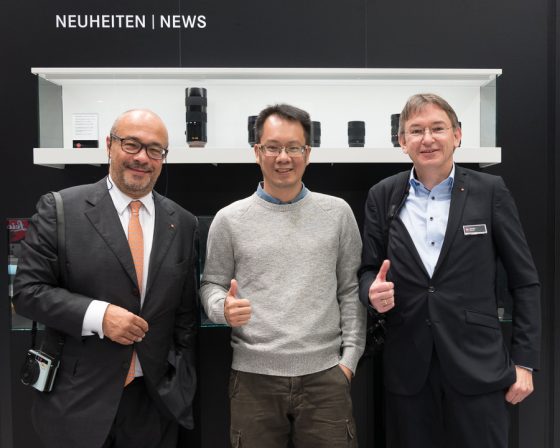
Enche Tjin sent me his interesting Photokina interview with Dr. Kauffman and Stefan Schulz from Leica:
Enche Tjin: First of all, I would like to congratulate Mr. Stefan Schulz who just got appointed to Global Director Business Unit Professional. Can you tell me a bit about your role in this new position?
Stefan Schulz: Maybe I should rewind a few steps back. We started in 2007-2008 to develop the S system in order to approach the professional market a little bit stronger than before because we saw this market has some potential and the brand also has a very good fit to professional market from its history.
Hmm.. after that, the completion of the portfolio for us by taking over Sinar, in order to have technical camera sector and enable photographer also to have kind of still life and advertising photography in the studio that you can not do with camera that is not flexible.
And later on in 2015 we completed a very fast 35mm autofocus system. Now we have the complete setup more than any other company. Now we thought that it is the right time to set up the organization. Besides having the product, we need to serve customers in a more organized way; more dedicated to professionals and their needs.
So that’s the part of the role. That means we don’t just care about product and product management but now as well dedicated marketing, sales and service. So we set up a more customer centric approach.
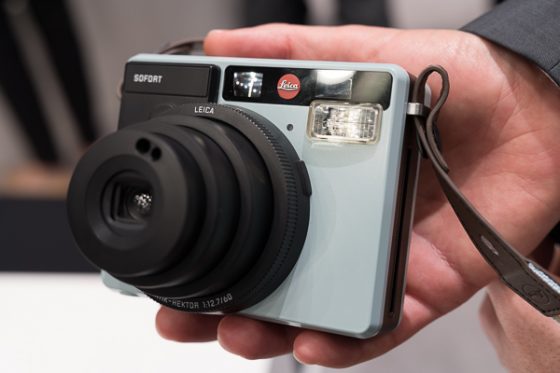
Enche Tjin: I’d like to ask about the newest camera, Leica Sofort. Why did Leica suddenly jump into the instant camera market?
Dr. Andreas Kauffman: You have to understand it. This (point at Leica Sofort) and this (point at smartphone Huawei P9). We went to this partner and we had a five year contract to develop things together with them, and we also went into this (point at Leica Sofort). Because this is analogue, and for someone who would mainly use this one… the process that suddenly oops. .. there is a picture. We think this addressed a certain group of consumers who formerly had never seen a paper picture.
On the other hand, into the digital social media, etc, and, back to the basics you could say, an analogue picture and in that case, it’s unique you can’t change it. Even formerly a negative you sort of add a few things, retouch in a dark room. This is basically the purest photography possible. You can’t change anything.
For us, this is a different type of photography, and we think it is also a certain type of photography. And we work together. Sometime we work together with Fuji. We use the Instax system, because it is the most advanced system for instant photography.

Enche Tjin: What is unique about the new SL 50mm f/1.4 lens? Will this lens set a new standard? Will it be the best 50mm? How does it compare with Zeiss Otus series? Will it compete with or give medium format quality? And when it will be available?
Stefan Schulz: About the lenses… We have three kinds of new lenses, the 50mm f/1.4. We show Summicron roadmap: 90mm, 75mm, and 35mm and we show a third zoom lens 16-35mm. So, besides the 50mm, the lenses will come in the second half of next year.
The 50mm will be available in January. We have already sampled it in the booth, final optical and mechanical quality. You can test it if you want.
Why add one more 50mm lens to the market? Because the market has already seen a lot of 50mm lenses. We always try to make unique lenses; and this lens exceeds the limit that there is in the market. I don’t want to compare it with other lenses. but it is a reference lens. It is not only a reference in optical quality, but also in how it looks; it’s a very nice Leica look. Besides that, mechanically, it is very robust, it has a very nice autofocus and it is sealed against water splashes and dust.
There is no other lens in its class that offers all the capability besides its optical performance. It’s not just about optical perfomance. it is also how you operate it. To have a manual focus lens is fine, but not for today’s requirement.
Your question about the medium format; we think many people only think about resolution when they talk about medium format. Medium format is more than just resolution. Medium format is a bigger format and a different look. Resolution is one side, and the look is the other side.
Medium format gives resource to photographers. Photographers are not always so precise on how they work. To have a very high-end 35 system camera with a very good lens, and high resolution sensor, you can make a very nice image.
But practically, in daily job of a photographer, it is easier with medium format. It gives more resource and needs less precision on how you work. For that we still develop the S system, and having introduced S007 last year, it was the lastest CMOS technology what it can do with 37.5 MP is nice to see in Leica Gallery hall 1, when you see the giant from Bruce Gilden. It’s really big. Some people asked why I need more than 37.5 MP, and sometimes we show them such images and ask how big do you want to print?
Dr. Andreas Kauffman: Because if you need more megapixel, you could just use Nokia phone 41 MP. But look at the picture.
Stefan Schulz: When we launched S2 it was not the highest resolution medium format, but it was the fastest, and is still the fastest. The 007 is an incredibly fast medium format camera. This is what people really need. And this one (Leica SL 601). When we decided to go mirrorless, we knew when we had to replace the mirror. Photographers always like to see just after the image, again the scene. In DSLR they have just maybe 80ms then the image is back. We have the same here.
With slower frame rate medium format camera. Many people say we don’t need 11 fps. That’s true, but you need 11 fps in order to have instantly the viewfinder image after the shoot. This is for your experience. On the other camera you don’t see what’s going on anymore.
Mirrorless camera always have to a very high frame rate otherwise you don’t have a viewfinder image instantly available after the shot. Mirrorless cameras need to have a very fast frame rate.
Enche Tjin: Hasselblad and Fuji just announced their mirrorless medium format camera. What do you think about the competitors? Will S System goes mirrorless?
Stefan Schulz: I think basically that Fuji and Hasselblad…showing you product in medium format camera. This is very good. Because it shows this is the beginning that medium format cameras are not only about resolution. But there is interest in MF. It shows some demand and interest in medium format. This is good for all medium markets.
For the moment, just like what we already said. You need to take a quick look at the viewfinder. Current medium format cameras have slow frame rates, so after you take a picture, you see nothing. S system is showing instant image. As long as there is no technology for medium format available that gives instant images like this, we will not change.
Dr. Andreas Kauffman: I think. Usually I don’t talk about competitors, but we don’t completely see them as competitors. When you saw the press release regarding Hasselblad mirrorless, and you read specs for the viewfinder. It is small. My personal opinion is that you can’t do it in medium format with viewfinder with 2 point whatever. To me, it is bad quality.
Stefan Schulz: That is not state of the art. And this is not what the experienced photographers want to see.
Just yesterday, I got a photographer handed over from Hasselblad from a former colleague who said he wanted to look at Leica, and he was very amazed at the Leica S system. He needed a really fast camera to see what’s going on. I think this is the minimum level of electronic viewfinder a photographer can accept for full frame format. You can’t get lower.
Enche Tjin: Is there any possibility of smaller cameras and lenses for the SL system? For example, rangefinder style SL and smaller lenses with smaller aperture lenses such as f/2.8 lenses ?
Stefan Schulz: Somehow… what you’ve already seen, the Sumicron is much smaller and lightweight. The camera needs a very big viewfinder. It is like the medium format style viewfinder that needs space. We need the big battery, because photographers don’t want to change batteries after 100-200 shots. And this is very important. You also need a grip in order to carry heavy lenses.
That means we don’t intend to go smaller with the camera. And it is robust. It is made from pure aluminum. This is (points at Leica Q) a little more lightweight. It is still robust but it can’t compare with this. It is sealed against water splashes, dust, etc. It also has a robust lens mount in order to carry heavy lenses. But we think the camera body itself is not really big, compared to the current DSLR. This is a DSLR without mirror. It’s small.
The zoom lens is pretty big, but offering the most important range 24-90. Not only 70mm Because with 70mm you never get a nice portrait. With another system you would need to change to 70-200mm.
It solved a problem, maybe generated another, solving a problem by having the focal range, but bringing the problem with making it a little bit more heavy. We think it is a good trade off because you don’t need to change the lens when you need the focal range.
But we’re custom oriented. If people asks for a standard zoom lens that is smaller, maybe we will make that for next year. Why not?
Dr. Andreas Kauffman: We need to study the demand and if we can do it in the certain price range. Then it can be done. You can do everything and charge 25,000. But we probably won’t sell it.
Stefan Schulz: Basically we understand that we need a smaller standard zoom lens. On the other hand, we will need to have a look so that we don’t add things to the market that are already there. Due to the connectivity we offer and also working together with companies that offer adaptors like Novoflex, you can mount more or less all Canon lenses on it.
With autofocus, with everything. You can mount Nikon E lenses now. So there are already a lot of lenses that are small. Not Leica optical quality for sure, but we need to study what people want. Because only small lenses is not what people want. They want a small lens with Leica characteristics. We have to look if we can make that. But for the moment we are concentrating on the professional lineup.
Operation concepts are very similar to the S system; so people can change between both systems. You can use the S system lens as well on that camera. If you have one system you can continue with the next without buying new lenses.
Enche Tjin: How about Leica T ? and How about Leica X and X Vario line? I heard that X Vario is your favorite camera.
Dr. Andreas Kauffman: The T system is renamed to TL because SL and TL share the same L-mount. Basically T/TL is the APS-C system. When the T system comes into the market, we have the SL already in focus. That’s why the mount is the same, only for the smaller sensor. So I think you will see certain things with the TL, and the X. We have the X but what we skip is Leica Vario. Unfortunately so because I think it is probably the best zoom lens in APS-C system.
When I travel, I am an amateur photographer, and when I want to travel light I usually take my Leica Vario. It fulfills all of the needs of an amateur photographer. We were in Scotland for instance. I took my X Vario with me, and after that I printed out a photo book for my family; beautiful pictures.
Maybe our marketing for X Vario could’ve been enhanced. And so, at the end we need to decide. Remember we are a small to medium sized enterprise. We have a huge range of products, maybe the biggest in the industry because we still also do an analogue camera. And sometimes you have to decide against your own personal wish. Okay, it is a great product, but it’s is the end of the lifecycle. We need to move on.
Enche Tjin: But how about TL? Will it continue for consumer oriented design like smaller camera, lenses…
Dr. Andreas Kauffman: If you asked our lens designer Peter Karbe, sometimes he says Oscar Barnack nowadays will do APS-C system. Quality and size fit perfectly together for certain needs. So yes, APS-C / TL. That marketplace, we will stay there, definitely.
Stefan Schulz: It is also for this system. Because, besides photography capability this is (SL) a high end video camera. 4K is Super 35mm window format. For that, we need the TL lenses because then you have very high end lenses offering wide angle capabilities. Due to the crop, we can have full range of wide angle capabilities.
And the lenses are on the same optical level than this (SL). You have no lower image quality. This is different. Most of APS-C’s system in the market is entry level system . This is different with the TL. The TL is not entry level quality, it’s high end quality.
Enche Tjin: Leica has partnered with many companies, including Huawei, Fujifilm, Sonderoptic for Cine lenses, and especially Panasonic. Can you discuss about your partnerships?
Dr. Andreas Kauffman: First, it’s already been 15 years. You have to understand our situation. We are the last company in Europe of a certain size in this segment. Which means a lot of supplying industry is in Asia.
Leica first started incorporting Minolta 1972 already. We need to work with some because we are a small scale high end producer, so we need input from more mass producer oriented company. And that’s how we work together with them.
You’ll find in 2012 in Asahi camera in Japan. There is an interview with a lens designer from Panasonic. And in there they said, what they learn from Leica. Panasonic learns a lot in the way how we see optics. On the other hand, we can use out of their supply range a lot of electronic products. I think it is a good partnership, taking the best of both worlds.
Enche Tjin: How about Panasonic Leica lenses?
Dr. Andreas Kauffman: When you buy a Panasonic Leica lens, it’s certified Leica quality. Quite simple.
Stefan Schulz: Not just the label, but it is checked by Leica optical department for quality and construction wise. Otherwise they are not allowed to do that.
Dr. Andreas Kauffman: So you can find a lot of lenses in Panasonic lens that you don’t see the Leica label, because it doesn’t fit in the quality range.
Enche Tjin: Is it possible that Leica design a micro four thirds camera ?
Dr. Andreas Kauffman: That is political question I would say… Ha ha ha… I will give my personal opinion APS-C is standard. I wont say better but it is the standard.
Enche Tjin: What do you think about Asia market, especially Indonesia market?
We just started in Indonesia. Indonesia has 200 million inhabitants. It is a huge market. We will do more but we can only do it step by step.
We first started in Asia with our own distribution in 2005 in Japan, and 2008 in Singapore. So we’re new. We will do more there, definitely. But we are small-scale company and we’ll do it step by step.
There is a followership of Leica users in Indonesia. I have a few of them as my friends on Facebook.
I personally see the Indonesian market as a very interesting one. And at the moment is driven via our Leica South East Asia Singapore company, which made it easy because Singapore is not that far.
Enche Tjin: In the last couple of years, Leica Stores are growing around the world, How’s that doing?
Dr. Andreas Kauffman : Not only stores but galleries. Not in every store. But the gallery is huge part of our marketing because it has the story of photography. And I was corrected yesterday, we will have 15 Leica Galleries worldwide. Some of them are very big ones. For example in LA, the gallery is 2000 square meters.
So we go step by step, not by e-commerce. When you try to buy Leica online, it’s pretty tricky, only a few dealers do it, and they usually don’t have enough stuff to sell.
So store by store, country by country. And if the store is big enough, it will have gallery element. We just opened the gallery in Boston.
Enche Tjin: People are usually curious of Leica products. But why are they so expensive?
Dr. Andreas Kauffman: We don’t do it for the high price it’s just necessary.
Stefan Schulz: The higher you go for quality, for maybe the last 5% of quality, you need to double the price because it has so much effort, and some other photo companies are very electronically driven. The focus on electronic only and tell people that electronic is the most important. But if you relax and you have the best electronics today, what it is worth in one year, it is an outdated electronic from yesterday.
So we focus very much on optic and mechanic as well. Because if you lean back two to five years optic and mechanic still has a value. We put a lot of effort into that long lasting value. Electronic is important, but not the only important thing.
Enche Tjin: Thank you for the opportunity.
Here are few more Leica/Photokina interviews in case you missed them (see also this post):
